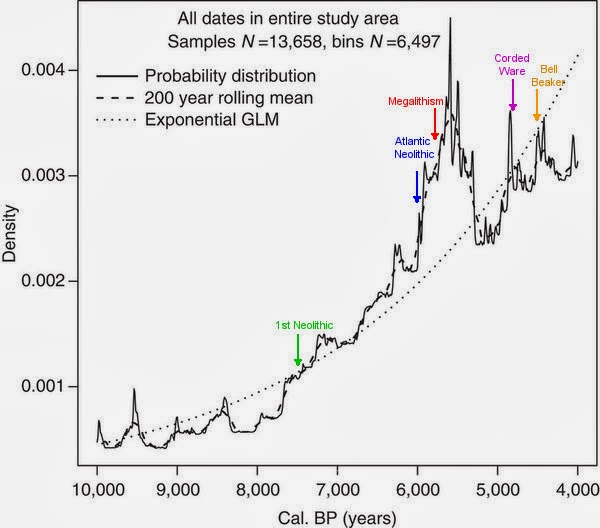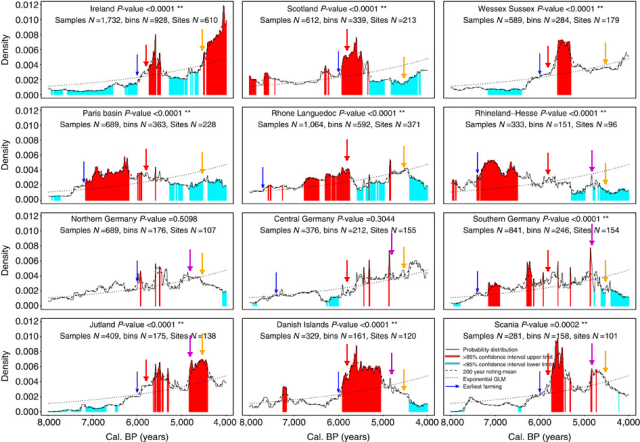Abstract
The discovery of Chauvet cave, at Vallon-Pont-d’Arc (Ardèche), in 1994, was an important event for our knowledge of palaeolithic parietal art as a whole. Its painted and engraved figures, thanks to their number (425 graphic units), and their excellent state of preservation, provide a documentary thesaurus comparable to that of the greatest sites known, and far beyond what had already been found in the group of Rhône valley caves (Ardèche and Gard). But its study – when one places it in its natural regional, cultural and thematic framework – makes it impossible to see it as an isolated entity of astonishing precocity. This needs to be reconsidered, and the affinities that our research has brought to light are clearly incompatible with the very early age which has been attributed to it. And if one extends this examination to the whole of the Franco-Cantabrian domain, the conclusion is inescapable: although Chauvet cave displays some unique characteristics (like every decorated cave), it belongs to an evolved phase of parietal art that is far removed from the motifs of its origins (known from art on blocks and on shelter walls dated by stratigraphy to the Aurignacian, in France and Cantabrian Spain). The majority of its works are therefore to be placed, quite normally, within the framework of the well-defined artistic creations of the Gravettian and Solutrean. Moreover, this phase of the Middle Upper Palaeolithic (26,000–18,000) coincides with a particularly intensive and diversified local human occupation, unknown in earlier periods and far less dense afterwards in the Magdalenian. A detailed critique of the treatment of the samples subjected to AMS radiocarbon dating makes it impossible to retain the very early age (36,000 cal BP) attributed by some authors to the painted and engraved figures of Chauvet cave.
Category Archives: France
Grotte Chauvet’s Aurignacian dates strongly questioned
Neolithic and Chalcolithic demographics of Western and Northern Europe
Abstract
Following its initial arrival in SE Europe 8,500 years ago agriculture spread throughout the continent, changing food production and consumption patterns and increasing population densities. Here we show that, in contrast to the steady population growth usually assumed, the introduction of agriculture into Europe was followed by a boom-and-bust pattern in the density of regional populations. We demonstrate that summed calibrated radiocarbon date distributions and simulation can be used to test the significance of these demographic booms and busts in the context of uncertainty in the radiocarbon date calibration curve and archaeological sampling. We report these results for Central and Northwest Europe between 8,000 and 4,000 cal. BP and investigate the relationship between these patterns and climate. However, we find no evidence to support a relationship. Our results thus suggest that the demographic patterns may have arisen from endogenous causes, although this remains speculative.
 |
|
Figure 2: SCDPD-inferred population density change 10,000–4,000 cal. BP using all radiocarbon dates in the western Europe database. Colored arrows and their annotations are mine. |
Rhône-Provence Bell Beaker
Abstract (only part in English)
Where are the famous Bell Beaker individual burials in the south east of France? What is the nature of the burials wherein we actually find Bell Beaker elements ? And what kind of Bell Beaker is it ? And also : where does the Bell Beakers stand in the evolution of the funeral architectures and rites between the end of the Middle Neolithic and the Early Bronze Age? Answering these questions, thanks to the presence of more than a hundred funeral sites in the area, would change our vision of the Bell Beakers fenomenon itself. These questions are also the occasion to present the diversity and the traditions of the funeral practices by the 3rd millenium BC.
- Corded style in Ardèche
- International style in the left margins of the Rhône
- A local variant in the later period
- individual burials with roots in early Neolithic
- collective burials of both dolmenic-megalithic and cave typology
- other rarer types, with a handful of examples each
Screw stoppers of Upper Paleolithic Dordogne
 |
| Drawing of two ivory stoppers from Combe-Capelle and Fourneau du Diable (from Don’s Maps, ultimately from S. Lwoff 1968) |
 |
| Stopper of bone from Laugerie-Haute (Magdalenian) |
Maps of lamp usage in Paleolithic SW Europe
 |
| Illustration by Arturo Asensio Decorating Altamira Cave |
 |
| Lamps found in France with chronology and type of site (Beaune & White 1993) |
 |
| Lamps found in Iberia (by David Sánchez) |
Alert: Foissac cave threatened by pig farm expansion
Mairie de Causse et Diège, Loupiac
12 700 CAUSSE ET DIEGE.
mobile phone : 06 11 75 97 02
Grotte de Foissac : 05 65 64 60 52
Timeline of the conquest of Navarre by Castile 1512-21
 |
| Navarre and associated states c. 1512 |
 |
| Reconstruction of the historical walls of Tudela on a modern photo |
 |
| Wall of Pamplona |
 |
| Andrew of Foix, Lord of Asparrot |
 |
| Monolith of Amaiur |
Another decorated cave discovered in Ardèche
The Ardèche or Ardacha region, so-named for a tributary of the Rhône, is one of the most important and older districts of modern human presence in SW Europe. Its importance was underlined with the discovery of the Grôte Chauvet, the cave of lions.
Now another discovery has been made in the same area with a decoration of what seems to be a horse head. The finding actually was made in 2011 by some speleologist but kept secret till it was researched preliminarily.
Sources[fr]: Pileta, France 3, Paleos Blog.
Basque-specific mtDNA lineages
A reader points me to this paper (in Spanish with introduction in Basque):
Regarding U5b, a particular sublineage U5b1f is mentioned as being notably frequent among Basques and also found in other sub-Pyrenean populations (Crespillo et al. 2000; Martínez-Jarreta et al. 2000; Alfonso-Sánchez et al. 2008).
The highest apportion of U5b worldwide is in Northern Navarre (15.5%).
[Update: in the comments section, Heraus, who has deep Bearnois roots, confirms my hypothesis: U5b1b may not be found among Basques but it’s found for sure among Gascons. Himself is this particular lineage].
 |
| Franco-Cantabrian province: dots indicate rock art sites, white areas are glaciers, light green is land now submerged |
Update (June 22):
U5b frequencies by Argiedude (synthesis of many diverse papers):
 |
| Click to enlarge. Figures in percentile points. |
See the discussion for details. Importantly he argues that he is working in a diversity map but that preliminary data appears to show that U5b in SW Europe is more diverse than in Fenno-Scandia (I’d be surprised if it’d be the other way around, honestly, because this region was covered in ice until some 10,000 year ago).
Update (June 29): Argiedude has also worked out this map of U5b diversity (see comments):
Not sure what conclusions may be reached, if any.
Provenzal genetic data… and weird speculations
Using putative Neolithic Anatolian lineages: J2a-dys445=6, G2a-M406 and J2a1b1-M92 the data predict a 0% Neolithic contribution to Provence from Anatolia.
- E1b1b1b1a2 (V13): 4%
- E1b1b1b1c (M123): 2%
- G(xG2a3a) (M201): 8%
- I1 (M253): 2%
- I2(xI2a2,I2b) (M438): 4%
- J1 (M497): 2%
- J2a4h1a (DYS445=6): 8%
- J2a4b(J2a4b1) (M67): 2%
- R1a1a (M198): 10%
- R1b1b2 (M269): 59%







